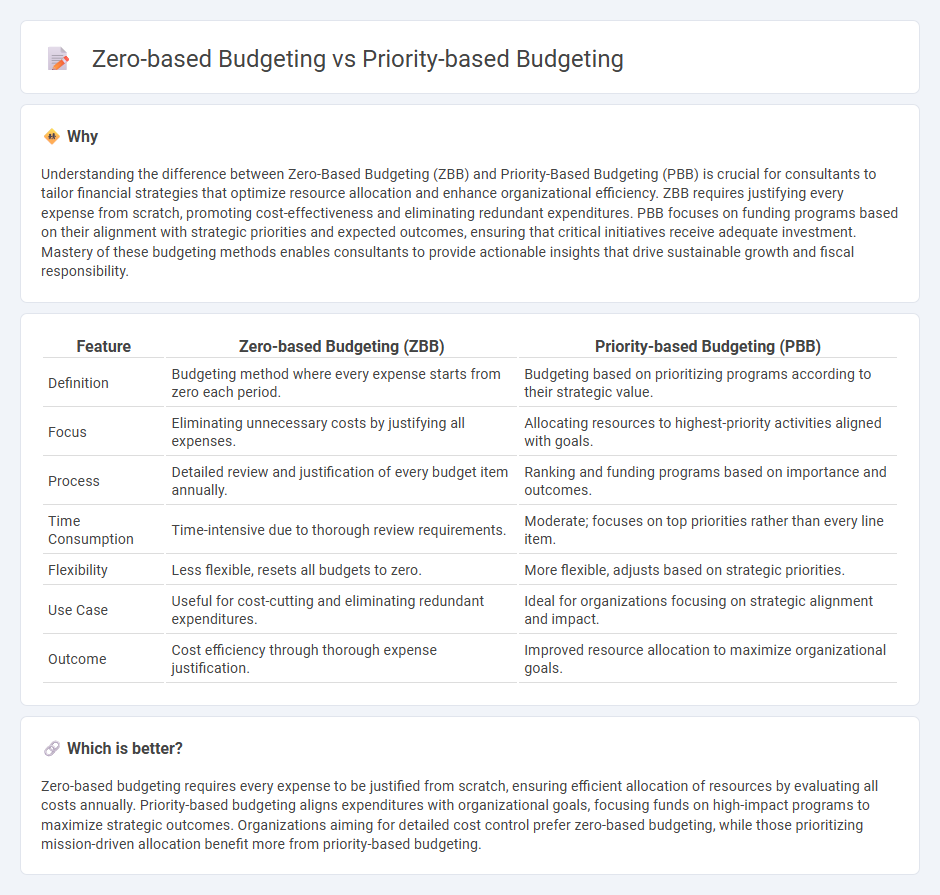
Zero-based budgeting requires justification for every expense, starting from a "zero base," ensuring resource allocation aligns strictly with current needs. Priority-based budgeting ranks programs and services by importance, directing funds to the highest-value activities based on organizational goals. Explore the key differences between these budgeting methods to optimize your financial planning strategy.
Why it is important
Understanding the difference between Zero-Based Budgeting (ZBB) and Priority-Based Budgeting (PBB) is crucial for consultants to tailor financial strategies that optimize resource allocation and enhance organizational efficiency. ZBB requires justifying every expense from scratch, promoting cost-effectiveness and eliminating redundant expenditures. PBB focuses on funding programs based on their alignment with strategic priorities and expected outcomes, ensuring that critical initiatives receive adequate investment. Mastery of these budgeting methods enables consultants to provide actionable insights that drive sustainable growth and fiscal responsibility.
Comparison Table
| Feature | Zero-based Budgeting (ZBB) | Priority-based Budgeting (PBB) |
|---|---|---|
| Definition | Budgeting method where every expense starts from zero each period. | Budgeting based on prioritizing programs according to their strategic value. |
| Focus | Eliminating unnecessary costs by justifying all expenses. | Allocating resources to highest-priority activities aligned with goals. |
| Process | Detailed review and justification of every budget item annually. | Ranking and funding programs based on importance and outcomes. |
| Time Consumption | Time-intensive due to thorough review requirements. | Moderate; focuses on top priorities rather than every line item. |
| Flexibility | Less flexible, resets all budgets to zero. | More flexible, adjusts based on strategic priorities. |
| Use Case | Useful for cost-cutting and eliminating redundant expenditures. | Ideal for organizations focusing on strategic alignment and impact. |
| Outcome | Cost efficiency through thorough expense justification. | Improved resource allocation to maximize organizational goals. |
Which is better?
Zero-based budgeting requires every expense to be justified from scratch, ensuring efficient allocation of resources by evaluating all costs annually. Priority-based budgeting aligns expenditures with organizational goals, focusing funds on high-impact programs to maximize strategic outcomes. Organizations aiming for detailed cost control prefer zero-based budgeting, while those prioritizing mission-driven allocation benefit more from priority-based budgeting.
Connection
Zero-based budgeting and priority-based budgeting are interconnected budgeting approaches that emphasize efficient resource allocation by focusing on justification and prioritization of expenses. Zero-based budgeting requires every expense to be justified from zero each period, promoting cost-effectiveness and eliminating redundant spending. Priority-based budgeting ranks budget items based on organizational goals and outcomes, ensuring funds are allocated to the highest-impact initiatives identified through zero-based analysis.
Key Terms
Resource Allocation
Priority-based budgeting allocates resources according to the importance and impact of programs, ensuring high-value initiatives receive sufficient funding. Zero-based budgeting requires every expense to be justified from scratch, promoting efficiency by eliminating unnecessary costs and reallocating funds based on current needs rather than historical budgets. Explore more to understand how these approaches optimize resource allocation and improve financial management.
Cost Justification
Priority-based budgeting allocates resources according to the importance of programs, ensuring funds support initiatives with the highest impact on strategic goals. Zero-based budgeting requires each expense to be justified from scratch, promoting rigorous cost scrutiny and eliminating non-essential expenditures. Explore detailed comparisons to identify the most effective budgeting approach for your organization's financial management needs.
Strategic Alignment
Priority-based budgeting allocates resources based on strategic importance and organizational goals, ensuring funds are directed toward high-impact initiatives. Zero-based budgeting requires each expense to be justified from scratch, promoting cost efficiency but potentially overlooking strategic priorities. Explore detailed comparisons to understand which method best aligns with your strategic objectives.
Source and External Links
The Advantages and Disadvantages of Priority Based Budgeting - Priority based budgeting (PBB) reorganizes budgets by prioritizing programs and services based on their importance and outcomes, helping organizations allocate resources efficiently, challenge historical spending, and maintain fiscal sustainability while focusing on high-value services.
Anatomy of a Priority-Driven Budget Process - GFOA - Priority-driven budgeting allocates resources according to how well programs meet community goals, replacing incremental budgeting by scoring and comparing programs on agreed-upon priorities to guide allocation and accountability.
Priority Based Budgeting Software | Tyler Technologies - This budgeting approach aligns funding decisions with strategic priorities and desired outcomes, ensuring transparency and accountability by assigning values to programs so that high-value services continue while lower-value ones may be reduced or eliminated.
 dowidth.com
dowidth.com